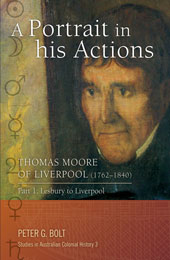A Portrait in his Actions - Thomas Moore of Liverpool: Part 1 by Peter Bolt
One sad event for me last year was the winding up of the estate of Thomas Moore. He died in 1840, leaving a considerable estate to Christian purposes — which have included the founding and sustaining of Moore College.
I was saddened by the event because we need all the historical reminders we can get. I am not suggesting we return to some of our predecessors’ monumental efforts but God works in history and his work is often accomplished through individuals who commit themselves to him and see his hand of blessing on their lives. When we remember such witnesses, we are celebrating and learning from the work of God.
Biography is not the only form of church history by any means but it is an honourable profession and, when well done, can be illuminating and provoking. Sir Marcus Loane was especially good at biography and has left an important legacy of works. More recently, Dr Marcia Cameron has given us a fascinating account of the life of Dr Broughton Knox — and more work is being done on the principals before Knox by Dr John McIntosh. We need to know why our Diocese has been shaped as it has.

Into this field has come the indefatigable Dr Peter Bolt. He produced an important biography for the 2009 bicentenary of the coming of the great William Cowper to Sydney and now, with amazing speed, has published the first of a projected two volumes on Thomas Moore. This is not his first book on Moore, but he has managed to turn one of the least known of the leading men of the early colony into one whose life is richly detailed.
The beginnings of our city have engaged my attention for some time now, after an earlier period of ignorance and indifference. The general sense that Australia was an unimportant outpost of empire and that our history was dull and insignificant has been replaced, for me, by a sense of wonder at the great project of settlement and its effects on the first people and the landscape.
These beginnings of our history fit into and cannot be understood apart from the tumultuous events occurring in Europe and America at the time and the cultural history — scientific, moral, political — of the period. It is no wonder men like William Wilberforce took a keen interest in what was happening here, and no accident that his name is commemorated in the town named after him. But so many of our towns and streets and districts commemorate people (Pitt, Dundas, Bronte) and events (Camperdown, Trafalgar) that were engrossing the interest of the world and shaping our nation’s development.
I am reading the book carefully — and others more knowledgeable than I will review it. However, my initial report is that Peter Bolt has taken for his subject one of the key laymen who created our local Anglicanism under God. He has given him the detailed attention he deserves, not only as an Anglican layman but also in his own right as a prominent pioneer of our nation.
He has done more than produce an ecclesiastical biography. He has set Moore into the context of early Sydney (and its world) and contributed significantly to our knowledge of what occurred in this town in its earliest days. He has uncovered sources hitherto unknown or unused. He has begun to explain how it is that one as humble as Moore in background and education could make provision for the founding of what amounted to Australia’s first tertiary educational institution. At the same time he has told intriguing tales of Moore’s marriage to an emancipated convict, his part in the rebellion against Governor Bligh, his achievement in building the first European boat in New Zealand and other stories.
I hope we will all take an interest in what God has done for us and among us. Peter Bolt has served us well in giving us this book. I commend it to you.















